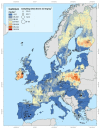The Mechanisms of Cadmium Toxicity in Living Organisms
- PMID: 39771090
- PMCID: PMC11679562
- DOI: 10.3390/toxics12120875
The Mechanisms of Cadmium Toxicity in Living Organisms
Abstract
Cadmium (Cd) is a toxic metal primarily found as a by-product of zinc production. Cd was a proven carcinogen, and exposure to this metal has been linked to various adverse health effects, which were first reported in the mid-19th century and thoroughly investigated by the 20th century. The toxicokinetics and dynamics of Cd reveal its propensity for long biological retention and predominant storage in soft tissues. Until the 1950s, Cd pollution was caused by industrial activities, whereas nowadays, the main source is phosphate fertilizers, which strongly contaminate soil and water and affect human health and ecosystems. Cd enters the human body mainly through ingestion and inhalation, with food and tobacco smoke being the primary sources. It accumulates in various organs, particularly the kidney and liver, and is known to cause severe health problems, including renal dysfunction, bone diseases, cardiovascular problems, and many others. On a cellular level, Cd disrupts numerous biological processes, inducing oxidative stress generation and DNA damage. This comprehensive review explores Cd pollution, accumulation, distribution, and biological impacts on bacteria, fungi, edible mushrooms, plants, animals, and humans on a molecular level. Molecular aspects of carcinogenesis, apoptosis, autophagy, specific gene expression, stress protein synthesis, and ROS formation caused by Cd were discussed as well. This paper also summarizes how Cd is removed from contaminated environments and the human body.
Keywords: Cd pollution; Cd toxicity; animals; bacteria; human; molecular mechanisms; plants.
Conflict of interest statement
The authors declare no conflicts of interest.
Figures









Similar articles
-
The Minderoo-Monaco Commission on Plastics and Human Health.Ann Glob Health. 2023 Mar 21;89(1):23. doi: 10.5334/aogh.4056. eCollection 2023. Ann Glob Health. 2023. PMID: 36969097 Free PMC article. Review.
-
Pasture soils contaminated with fertilizer-derived cadmium and fluorine: livestock effects.Rev Environ Contam Toxicol. 2008;192:29-66. doi: 10.1007/978-0-387-71724-1_2. Rev Environ Contam Toxicol. 2008. PMID: 18020303 Review.
-
A review on Cadmium Exposure in the Population and Intervention Strategies Against Cadmium Toxicity.Bull Environ Contam Toxicol. 2021 Jan;106(1):65-74. doi: 10.1007/s00128-020-03088-1. Epub 2021 Jan 23. Bull Environ Contam Toxicol. 2021. PMID: 33486543 Review.
-
The Effects of Cadmium Toxicity.Int J Environ Res Public Health. 2020 May 26;17(11):3782. doi: 10.3390/ijerph17113782. Int J Environ Res Public Health. 2020. PMID: 32466586 Free PMC article. Review.
-
The adverse impact of cadmium on immune function and lung host defense.Semin Cell Dev Biol. 2021 Jul;115:70-76. doi: 10.1016/j.semcdb.2020.10.007. Epub 2020 Nov 3. Semin Cell Dev Biol. 2021. PMID: 33158728 Free PMC article.
Cited by
-
Modulation of TvRAD51 Recombinase in Trichomonas vaginalis by Zinc and Cadmium as a Potential Mechanism for Genotoxic Stress Response.Pathogens. 2025 Jun 5;14(6):565. doi: 10.3390/pathogens14060565. Pathogens. 2025. PMID: 40559573 Free PMC article.
-
Effects of amino acids on the germination and Cd accumulation in soybeans exposed to cadmium.Biometals. 2025 Aug;38(4):1337-1353. doi: 10.1007/s10534-025-00709-2. Epub 2025 Jun 18. Biometals. 2025. PMID: 40533709
-
Evaluation of Theobroma cacao L. as a bioindicator for cadmium contamination through H2O2 electrochemical analysis.Sci Rep. 2025 Jul 23;15(1):26715. doi: 10.1038/s41598-025-11715-2. Sci Rep. 2025. PMID: 40695947 Free PMC article.
References
-
- Thomas O. Llewellyn IC 9380 Cadmium (Materials Flow) The National Institute for Occupational Safety and Health (NIOSH); Washington, DC, USA: 1994.
-
- Goering P.L., Waalkes M.P., Klaassen C.D. Toxicology of Metals. Springer; Berlin/Heidelberg, Germany: 1995. Toxicology of Cadmium; pp. 189–214. - DOI
Publication types
Grants and funding
LinkOut - more resources
Full Text Sources

